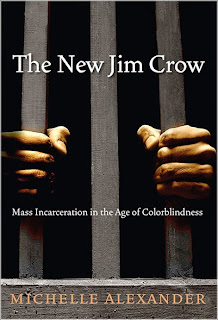The New Jim Crow: A First Look
A democratic society requires mature, public conversation about issues of importance. Facebook CEO Mark Zuckerberg has convoked "A Year of Books" to offer such an opportunity. This commentary is part of a series of commentaries on each of the readings proposed by Zuckerberg. My commentary on Michelle Alexander's The New Jim Crow: Mass Incarceration in the Age of Colorblindness will have multiple entries for this truly remarkable book. This is the first of those entries.
The New Jim Crow walks us through some of Zuckerberg's previous readings. An important element throughout Alexander's argument is the data about declining violence that inspired Steven Pinker's work (for example, p. 41). Sudhir Venkatesh's mentor, William Julius Williams appears a couple of times (p. 34, p. 50). Venkatesh himself is cited in an endnote regarding Chicago's Robert Taylor Homes (p. 196). George Orwell and doublespeak make an appearance, too (p. 131).
While not explicitly cited, Moisés Naím's The End of Power might deepen questions about who has the power to change things? Thomas Kuhn's Structures of a Scientific Revolution may clarify questions about what changes in concept are at work in moving from slavery to Jim Crow to mass incarceration. Kuhn's format may structure thought about what changes in paradigm are needed to move from racial indifference to a genuine care and compassion for those who are different. Michael Chwe's Rational Ritual would suggest, via game theory, the common knowledge about race necessary for collective action to take place. While Zuckerberg may not have planned a progression from book to book, the books can be brought into dialog with one another.
Here is what Zuckerberg had to say about selecting the book:
For my part, and African-American pastor had recommended it to me the day before. I noted the title and had it to my "to do" list. Having read it, I would assert that The New Jim Crow is the most socially important book that I have read this year, and I most highly recommend it.
The initial chapter of The New Jim Crow invite us into a new way of seeing and the final chapter, "The Fire This Time" invite us into a new way of action. Having said that, I know the temptation to launch immediately into the final chapter, but I would strongly urge that the reader take all of the chapters in the order presented. For Alexander's argument to have its full force, one must look at the evidence she presents prior to evaluating her conclusions.
Additional commentaries on The New Jim Crow:
The New Jim Crow walks us through some of Zuckerberg's previous readings. An important element throughout Alexander's argument is the data about declining violence that inspired Steven Pinker's work (for example, p. 41). Sudhir Venkatesh's mentor, William Julius Williams appears a couple of times (p. 34, p. 50). Venkatesh himself is cited in an endnote regarding Chicago's Robert Taylor Homes (p. 196). George Orwell and doublespeak make an appearance, too (p. 131).
While not explicitly cited, Moisés Naím's The End of Power might deepen questions about who has the power to change things? Thomas Kuhn's Structures of a Scientific Revolution may clarify questions about what changes in concept are at work in moving from slavery to Jim Crow to mass incarceration. Kuhn's format may structure thought about what changes in paradigm are needed to move from racial indifference to a genuine care and compassion for those who are different. Michael Chwe's Rational Ritual would suggest, via game theory, the common knowledge about race necessary for collective action to take place. While Zuckerberg may not have planned a progression from book to book, the books can be brought into dialog with one another.
Here is what Zuckerberg had to say about selecting the book:
For my part, and African-American pastor had recommended it to me the day before. I noted the title and had it to my "to do" list. Having read it, I would assert that The New Jim Crow is the most socially important book that I have read this year, and I most highly recommend it.
The initial chapter of The New Jim Crow invite us into a new way of seeing and the final chapter, "The Fire This Time" invite us into a new way of action. Having said that, I know the temptation to launch immediately into the final chapter, but I would strongly urge that the reader take all of the chapters in the order presented. For Alexander's argument to have its full force, one must look at the evidence she presents prior to evaluating her conclusions.
Additional commentaries on The New Jim Crow:





Comments
Post a Comment